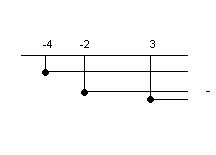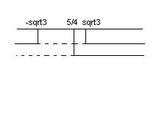[math]\sqrt{x+2}+\sqrt(x+4)>\sqrt(x-3)[/math]
[math]\sqrt{x+2}+\sqrt(x+4)>\sqrt(x-3)[/math]
;
Per l'esistenza della disequazione deve essere:
[math]\begin{cases} x+2>=0 \\ x+4>=0 \\ x-3>=0 \ \end{cases}[/math]
;
[math]\begin{cases} x>=-2 \\ x>=-4 \\ x>=3 \ \end{cases}[/math]
;
L'unione delle soluzioni sarà:

ovvero
[math]x>=3[/math]
.
In tale condizione i due membri sono positivi, elevando al quadrato si deve risolvere il sistema:
[math]\begin{cases} (\sqrt{x+2}+\sqrt(x+4))^2>(\sqrt(x-3))^2 \\ x>=3 \ \end{cases}[/math]
;
[math]\begin{cases} x+2+x+4+2\sqrt{(x+2)(x+4)}>x-3 \\ x>=3 \ \end{cases}[/math]
;
Semplificando
[math]\begin{cases} x+9+2\sqrt{(x+2)(x+4)}>0 \\ x>=3 \ \end{cases}[/math]
;
[math]\begin{cases} \sqrt{(x+2)(x+4)}>-(x+9)/2 \\ x>=3 \ \end{cases}[/math]
;
[math]\begin{cases} \sqrt{x^2+6x+8}>-(x+9)/2 \\ x>=3 \ \end{cases}[/math]
;
Risolviamo adesso l'equazione con un solo radicale, tenendo sempre presente la condizione
[math]x>=3[/math]
[math]\sqrt{x^2+6x+8}>-(x+9)/2[/math]
;
Essa è del tipo
[math]\sqrt{f(x)}>g(x)[/math]
quindi sarà equivalente al sistema:
[math]\begin{cases} f(x)>=0 \\ g(x)>0 \\ f(x)>[g(x)]^2 \ \end{cases}[/math]
;
Nel nostro caso
[math]f(x)=x^2+6x+8 ^^ g(x)=-(x+9)/2[/math]
.
Quindi la disequazione è equivalente al sistema:
[math]\begin{cases} x^2+6x+8>=0 \\ x^2+6x+8>(-(x+9)/2)^2 \\ -(x+9)/2>0 \ \end{cases}[/math]
;
[math]\begin{cases} x^2+6x+8>=0 \\ x^2+6x+8>(x^2+81+18x)/4 \\ -x>-9 \ \end{cases}[/math]
;
[math]\begin{cases} x^2+6x+8>=0 \\ 4x^2+24x+32>x^2+81+18x \\ x>9 \ \end{cases}[/math]
;
[math]\begin{cases} x^2+6x+8>=0 \\ 3x^2+6x-49>0 \\ x>9 \ \end{cases}[/math]
;
Studiamo separatamente le prime due
disequazioni:
1)x^2+6x+8>=0
[math](Delta)/4=(b/2)^2-ac=(3)^2-(1 \cdot 8)=9-8=1[/math]
[math]x_(1,2)=(-b/2+-\sqrt{(Delta)/4})/a=(-3+-\sqrt1)=(-3+-1) => x_1=-4 ^^ x_2=-2[/math]
.
Siccome il segno del coefficiente di
[math]x^2[/math]
è concorde col segno della disequazione,
prenderemo gli intervalli esterni, quindi soluzione della disequazione sarà:
[math]x>=-4 vv x>=-2[/math]
.
2)3x^2+6x-49>0
[math](Delta)/4=(b/2)^2-ac=(3)^2-(3 \cdot (-49))=9+147=156[/math]
[math]x_(1,2)=(-b/2+-\sqrt{(Delta)/4})/a=(-3+-\sqrt(156))/3=(-3+-2\sqrt(39))/3 => x_1=(-3+2\sqrt(39))/3 ^^ x_2=(-3-2\sqrt(39))/3[/math]
.
Siccome il segno del coefficiente di
[math]x^2[/math]
è concorde col segno della disequazione,
prenderemo gli intervalli esterni, quindi soluzione della disequazione sarà:
[math]x>(-3-2\sqrt{39})/3 vv x>(-3+2\sqrt{39})/3[/math]
.
La soluzione del sistema si otiene considerando l'intersezione delle soluzioni delle singole disequazioni che lo conengono,
ricordando la condizione
[math]x>=3[/math]
.
Pertanto
[math]S={x>=3}[/math]
.



![Disequazioni: [math]\sqrt{{{x}^{2}+{2}}}-\sqrt{{{3}{x}-{1}}}>{4}{x}[/math]](https://cdn.skuola.net/shared/thumb/159x141/news_foto/2017/10/dise_irra_e1.jpg)






 Accedi a tutti gli appunti
Accedi a tutti gli appunti
 Tutor AI: studia meglio e in meno tempo
Tutor AI: studia meglio e in meno tempo